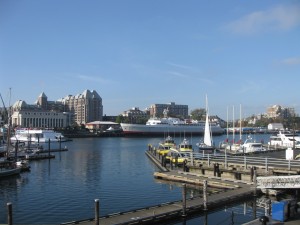Historic Victoria

Victoria rich in history
and tradition
- Kenneth Bagnell – Special to the Hamilton Spectator
- Wed Nov 9 2011
For years writers have described Victoria — the shining city and capital of British Columbia — as “more English than the English.”
It’s a graceful line that lingers. But is it apt? Not to John Adams. He’s the scholarly historian who operates a guiding agency taking about 13,000 visitors through his city every year.
“We were diverse from the very beginning,” he told me. “Yes there were many English but also Irish, Scottish, German, Italian, Chinese. Most of us smile when we’re described as more English than the English.”
Barbara and I deliberately settled just outside Victoria proper for our visit. We chose Oak Bay, and a bed and breakfast owned by Egle and Derek Vair, who in 2007 moved from Ontario to fulfil an ambition: owning and operating an inn. Their Oak Bay Guest House is a member of a select group, Victoria’s Historic Inns, seven of them, some former luxurious mansions. One, Prior House is the former home of a B.C. premier.
Oak Bay Guest House had much to commend it: a large home, its original building from 1911, is now sheltered among holly, cedars and azalea trees. Rates are quite reasonable, some doubles were $80 a night.
“We deliberately keep prices moderate,” says Egle. “We’re not a stately mansion but we offer a very comfortable stay.”
Everywhere we travel, if it’s available, we use public transit. In Victoria, we’d walk six or seven minutes from Oak Bay Guest House for a comfortable bus, arriving 15 minutes later in the centre of Victoria.
It’s a small city, now having a population of just over 80,000. To me the heart of the city became Government Street, which got its name in 1856 when Victoria held its first elected assembly in a small log building very close to where the street now runs.
The street, with broad sidewalks lined by beautiful oval shaped trees, has its inevitable small shops and souvenir stands, but a stroll also offers a window on a memorable era of striking architecture.
Take for example, a building at 1022, now a fine bar and restaurant, but for many years a bank, in an age when banks were a great pleasure to the eye. It was here, in the Bank of Commerce in 1903, that young poet Robert Service worked as a teller, sleeping upstairs, as was bank policy back then, so as to deter robbers.
A man engraved forever on Victoria’s history is Francis Rattenbury. He had great talent in architecture, designing among other buildings two that should be at the top of a visitor’s list: British Columbia’s Legislative Building, and just a brief walk from it, Victoria’s loved Fairmont Empress Hotel.
It’s worth mentioning that, quite apart from what eventually happened to him, (he was murdered abroad provoked in part by an adulterous relationship) Rattenbury may well have been a prodigy: he won the competition to design these magnificent buildings when in his mid-twenties. They stand as great visual pleasure in city that’s a banquet of visual pleasure.
The “Parliament Buildings,” as they are spoken of by many Victorians, rise on the gentle slope of 12 acres of thick trees and engaging statuary, steps from yachts in the harbour. The building, opened in 1898, is Romanesque in form, its most striking aspect, to me, the many domes adorning its roof. We went inside, and while it was not then open for public tours, we did see the legislative chamber before coming outside to roam among gardens, trees and memorial stones which have so much to say if they’d ever speak.
A few years later, in 1908, Rattenbury’s second famous building rose steps away. In part because of its grandeur, but also its character and custom, The Empress Hotel has a place in national memory.
For a long time, like other grand hotels, it was a property of the CPR, but today it’s a member of Fairmont, which tends faithfully to tradition, including its famous afternoon tea.
We had a corner table, our window looking on the sweep of lawn. We sipped “The Empress Blend” and tasted a lot of pastries. (Pastry chef Jago Kaler, has arrived at 4 a.m. daily for roughly 30 years to prepare 800 to 1,000 pastries and scones.)
Most of all I’ll remember the century old atmosphere of the Empress and our server Marilyn, both recalling traditions that will always be part of old Victoria and thereby part of the legacy of Canada’s yesterday.
Special to The Hamilton Spectator
If you go
For information on visiting Victoria go to: Tourismvictoria.com. To contact Oak Bay Guest House: stay@oakbayguesthouse.com. For information on the group Victoria’s Historic Inns www.victoriashistoricinns.com. For guided walks by John Adams and his staff: discoverthepast.com.
